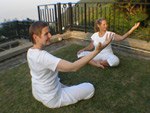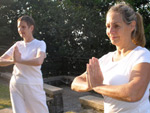
| About Nei Gong |
Exercises
The Technique
 |
The Nei Gong practice consists of holding exercises, “jing gong”, and moving exercises, “dong gong”. The main purpose of the “jing gong” is to collect the “qi” (energy) in the Lower Dan Tien, the energy center below the navel. They build up physical strength and flexibility, and help to slow down the breathing. |
The “dong gong” are repetitive movements coming from the pelvis and the spine with a beautiful flow. They are done either standing, sitting cross legged or lying down. They circulate the energy through the entire network of meridians and energy channels in the human body. The flow of the “qi” is very important, because where the “qi” flows, illness and disease cannot occur. Instead, healing can take place. As in water: if it flows, it is beautiful and clean. If it is stagnant, it becomes a breeding ground for illness.
Differences between Nei Gong, Qi Gong, and T’ai Chi
Nei Gong is the origin of all Taoist energy work. Qi Gong, T’ai Chi and Martial Arts are its “younger brothers”. They evolved and developed as a consequence of an understanding of parts of the Nei Gong, but not the whole.
Generally speaking, compared to Nei Gong, Qi Gong is more stationary and the energy is conducted through breathing and visualization which relates more to the fire tradition. In Nei Gong the energy is circulated through the repetitive movement, which comes from the spine and controls the whole body. The repetition brings in the meditative element, dissolving the dimension of time and space, leading you to greater awareness and more clarity. However, in T’ai Chi you move gently in a standing position through a set of different forms, with the movement coming from the hips.
With Nei Gong there is no visualization and your mind is on the “movement”. This brings body and mind together leading to a high concentration which comes about naturally. It brings the practioner into the “here and now”. It calms down, what the Taoist calls “the monkey mind”, the constant “noise of thoughts” in our head.
In the beginning the breathing is natural and later synchronized with the movements.
How do you practice
| The movements are done without using force and by moving within your limits. Therefore you adhere to the 70 % Taoist rule which makes the exercises safe for everyone. This way you learn to “listen” to your body and also to respect it. It is the complete opposite of the western “no pain – no gain” approach. |  |
The exercises are best learned and understood by doing, not by analyzing. The key to good results is perseverance and accumulation through regular practice.The power of this combination is often underestimated. Regular practice of 10-15 minutes a day is effective, however, even 5 minutes a day is better than nothing at all.
©2012 Tian Yan Nei Gong Centre. All Rights Reserved.
